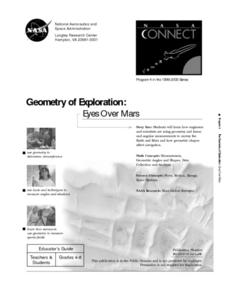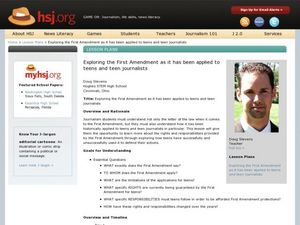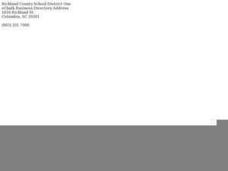Curated OER
REPRODUCTION
Students complete a variety of activities to study different concepts in Science. The activities are part of a layered curriculum. This is used to differentiate instruction and give a wide variety of assessment opportunities.
Curated OER
Geometry of Exploration: Eyes Over Mars
Students research how engineers and scientists generate linear and angular measurements with geometry to survey the Earth and Mars. They assess how geometric shapes affect navigation. A surveyor comes to the classroom and explains how he...
Curated OER
Sentence Game
Students explore and study what they already know about grammar and sentence structure to reinforce their mastery of assessing the eight parts of speech. They match a set of colored word cards with their correct part of speech and create...
Curated OER
Ten Crucial Days- How Can the Underdog Win?
Students identify the strategy that General Washington used to defeat a stronger force. In this Revolutionary War lesson, students investigate how Washington won the battles of Trenton and Princeton by watching the video Ten Crucial...
Curated OER
World Hunger
Students research the causes and effects of world hunger on children. In this world hunger lesson, students discuss causes and effects of hunger around the world and research a specific area affected by hunger. Students prepare a...
Curated OER
Jabberwocky Lesson Plan
Students complete a review of the parts of speech using a jabberwocky poem format. In this parts of speech and poetry lesson, students read a jabberwocky poem and identify parts of speech in the poem. Students list adjectives, verbs, and...
Curated OER
Landslides
Students study a natural disaster. For this landslides facts lesson, students discover how and why landslides happen and how they have an effect on people. They discuss this information as a class and then work in small groups to create...
Curated OER
Emotion Similes
Students define what a simile is before writing a poem that is based primarily on similes. They brainstorm and write the poem using the give format. They write drafts, revise and present a final poem.
Curated OER
Exploring the First Amendment as it has been applied to Teen Journalists
Students explore the First Amendment as it has been applied to teens and teen journalists. In this First Amendment lesson, students memorize the First Amendment, complete online research of the topic, and quiz. Students read about...
Curated OER
Mapping Landforms of South Carolina
Third graders analyze South Carolina maps. In this geography lesson, 3rd graders locate the five land regions in the state are and discuss how the regions are different. Students identify the major bodies of water and analyze how...
Curated OER
Changing Landforms
Students investigate different types of landforms. In this landforms lesson plan, students explore landforms by participating in a WebQuest. Students research the reasons behind landforms changing and create a picture using KidPix.
Curated OER
Is There Water on Mars?
Students decide whether or not there is or has even been water on Mars. They analyze temperature and pressure data from the Pathfinder mission to Mars, and then they analyze images of Mars, interpreting the landforms they see and...
Curated OER
Clouds
Learners discover how clouds form. They use the internet to read about the formation of clouds. They work together in groups to create their own clouds. They identify and label the four cloud types.
University of Hawaiʻi
Taxonomy and Me!
Taxonomy is the study of organisms and how you phylum. Three biology activities are included, helping scholars understand four of the six kingdoms, specifically Protista, Plantae, Fungi, and Animalia. Scholars observe and classify...
Teach Engineering
Maximum Power Point
Investigate the maximum power output of a photovoltaic panel with a instructional activity that introduces the class to the maximum power point. Individuals learn how to determine the maximum power point of a solar panel by using Ohm's...
Teach Engineering
Android Acceleration
Prepare to accelerate your Android. Pupils prep for the upcoming activity in this third installment of a four-part series. The lesson progresses nicely by first introducing different types of acceleration to the class. The teacher...
Bonneville
Why Use Renewable Energy?
Renew one's interest in renewable energy sources. Scholars learn about the advantages and disadvantages of various renewable and non-renewable energy sources. They conduct an activity to simulate the greenhouse effect and take part in a...
Minnesota Literacy Council
Scientific Method
Here is a resource with a descriptive approach to explaining the scientific method. It's simple, but effective for both introduction and reinforcement of this concept.
Purdue University
Slow Boat Design
Don't be a drag. Learners work in groups to design boats that move slowly. The provided reason for the activity is that a fish caught on a fishing reel is pulling the boat, causing it to move too fast. The STEM activity teaches the class...
Purdue University
Bottle Racers
Bottle up pupils' energy to complete a great resource. Scholars design toy cars out of plastic water bottles. They consider different sources of energy to power the cars, such as rubber bands, balloons, and chemical reactions.
Purdue University
Rolling with Roller Coasters
Sometimes science is all fun and games! A hands-on STEM lesson asks learners to design and create models of roller coasters. They analyze the motion using a marble and describe the areas of maximum kinetic and potential energy.
Curated OER
Dinosaurs 1: Where Are the Dinosaurs?
Students explore dinosaurs. In this dinosaur identification lesson, students watch video clips for different dinosaurs from the Discovery Kids website. Students discuss the clips with their teacher. Students may then role play the...
Curated OER
Quest for Gold
Students identify people involved in the Olympics in the past and explain how their ideas and actions have changed others' lives. they take notes during research and present the information in written or picture format.
Curated OER
Comparing and Ordering Numbers
Students compare, order, and measure objects. In this measurement lesson, students are assessed on their ability to order, compare, and measure objects. This is an assessment only lesson and does not include instruction.























